Dogfight: The most useless certificate
Which certificate serves less purpose: the one you get for bragging rights or the certificate in search of an aircraft? Readers weighed in on the debate.
I recently got a commercial glider certificate. That’s of very limited use, although it was fun to get and improved my skills. But, in the same spirit the FCC issues a number of certificates. Some, like the radiotelephone operator license, are very helpful (that one makes it legal to work on your radio transmitter). Others are more specialized for shipboard operators and technicians.
But this one is utterly useless: The radiotelegraph operator license lets you fix commercial Morse transmitters as well as get paid for sending code. The trouble is, there are virtually no such stations left! In the United States (and pretty much around the world) digital technology has replaced Morse. In this country only one museum and a few ship demonstration stations operate once in a while. (Code is alive and well—although proficiency is no longer required—on the ham bands, but that’s a whole different set of licenses.)
So there you have it, a nice government certificate, complete with its own regulations. Good for life, too. And except for the rare museum (where you don’t get paid anyway) there is no place to use it. And unlike powered lift, it is highly unlikely ever to be implemented again. Bragging rights.
Richard Weil
AOPA 3783046
St. Paul, Minnesota
I am one of those with a rather useless airline transport pilot-single-engine land, but it really seemed like a good idea at the time.
Upon graduating from Air Force pilot training, I took the required written exam and exchanged that for a commercial certificate/instrument rating. My commercial certificate read SEL, MEL limited to centerline thrust. After flying Lockheed C–141s for a while, I applied to have the restriction removed. What I should have asked for was for the local FSDO to sit on board when I took my next semiannual checkride. That, and the written, would have gotten me an ATP-MEL. But I was ignorant.
After leaving the Air Force I still wanted that certificate, as well as my CFI multiengine. At that time, prior to taking the written exam, you had to have your Class I physical. That was kind of pricey for me. But I paid for the physical, took the written, and ran out of money after getting the CFI-multi. Two years went by and my written expired.
Later I took the physical, passed the written, and then could not line up a twin-engine airplane for the flight check. Two years was coming up again.
Then I learned that if a person held an ATP-SEL, he did not need to retake the physical or written exam when applying for the ATP-MEL. So, I took the flight check in a Cessna 172. I don’t think that the examiner was happy about it, but she flew with me and signed me off.
But there is one more rating even more useless.
I decided that flying floats would be fun, so I went to a CFI in Maine for a three-day course. He saw my ATP and told me that if I wanted to fly an instrument approach he could add SES to my ATP certificate. Tempting, but I passed. One useless rating is enough.
Chris Hope
AOPA 771336
Kansas City, Missouri
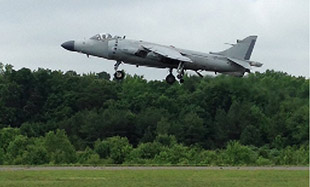 A Harrier requires a powered lift ticket. Here is a photo of our airport neighbor Art Nall departing our home ’drome St. Mary’s County, Maryland (2W6), in his Harrier. He recently acquired a two-seat Harrier and will shortly be training others to fly his Harriers.
A Harrier requires a powered lift ticket. Here is a photo of our airport neighbor Art Nall departing our home ’drome St. Mary’s County, Maryland (2W6), in his Harrier. He recently acquired a two-seat Harrier and will shortly be training others to fly his Harriers.
Ted Klapka
Tall Timbers, Maryland
A trip back in time
In my next life, I’m going to be a fly, and ride along on Barry Schiff’s shoulder on his wonderful adventures. I loved the H–47 Metalplane story. During some of my high school/college days, I was working in Catalina and commuting to Long Beach most weekends on the “Gooses.” I’ve been in love with water flying ever since and take sightseeing flights wherever I find the chance: most recently, Vancouver, British Columbia, and back via five stops in the Canadian Gulf Islands. We charter boats nearly every summer in those islands, have been through Pole Pass many times, and have spent many nights on Orcas Island, but have never been to the airport.
Thank you, Barry, for your writing, your wisdom, and for keeping my love for flying alive.
Bruce Kerr
AOPA 5461370
Long Beach, California
Frugal flier: A purpose-built GA helmet
I do not know if you are aware of the fact that Communications and Ear Protection was designed in conjunction with the U.S. Army at Fort Rucker, Alabama.
The whine of turbines is quite loud, as you know: 130 decibels in the cockpit of a CH–47 Chinook, as a matter of fact. I cannot speak about the Navy helmets, but the U.S. Army’s helmets are light and made to deaden as much sound as they can, and they do have CEP system.
Vern Childers
AOPA 5723570
Moore, Idaho
Pilot Counsel: VFR weather minimums
In John Yodice’s very good article on VFR weather minimums, one caution should be made. When one is above the ceiling flying VFR, then the term is “VFR over the top.” If on an IFR flight plan then ATC uses the term “VFR on top” (Order 7110.65, Section 3, 7-3-1, VFR on Top). Big difference. Why? Because of the potential dialog between VFR pilots and ATC. This would only be confusing to a VFR-only pilot, already over his head.
Tom Evans
AOPA 1151675
Tampa, Florida
Ramp rats
What a wonderful throwback in time it was for me to read Phil Scott’s article “Ramp Rats.” The article nudged me to recall my own youthful experiences in aviation.
I too started as a ramp rat while in my early teens at a now-defunct airport in Troy, Michigan, named Big Beaver. The owner, Annie Main, would spy me riding my bicycle while I snuck over the back-forty fence line to watch aircraft take off and land on her grass strip. She would come racing across the field in her ’55 Chevy pickup to chase the little interloper away.
Later, when I got a little smarter, I approached the airport from the front gate and did what ramp rats do. I would regularly wash and wipe my way to a free ride in whatever was offered. While in high school I got a real job at another local airport, as a compensated ramp rat! This is where I stumbled upon a derelict 1940 Piper J–3 Cub. Through much machinations my father, who was an A&P, and I purchased it. We restored it back to an airworthy Cub as the ultimate father/son project. I still own and fly the Cub regularly with my pilot-wife Carole, searching for more “rats.”
I now have thousands of hours flying everything from the Cub to corporate jets to warbirds. Almost every day I look back to those halcyon days of my youth with great pleasure knowing that the “gray beards” had provided the youthful me with life-altering opportunities and a lifetime of inspiration. Now I am one of the “gray beards,” and while at airshows, I still can see examples of ramp rats in spite of the armor plating of airports. Whenever the opportunity arises I will invite the “rat” over to touch, feel, smell, and experience grassroots historical aviation. Who knows, maybe it will inspire a future ATP, AMT, or astronaut.
Edward A. Vesely
AOPA 512314
Houston, Texas
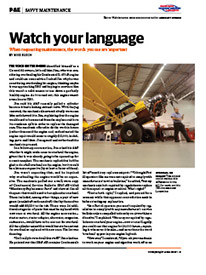 I read Mike Busch’s article twice, and then passed it on to a couple of students. In 45 years of flying more than 7,000 hours, I do believe that was the clearest, most helpful article I’ve ever read on IRAN versus overhaul versus new.
I read Mike Busch’s article twice, and then passed it on to a couple of students. In 45 years of flying more than 7,000 hours, I do believe that was the clearest, most helpful article I’ve ever read on IRAN versus overhaul versus new.
Don Henson
AOPA 616604
Ringgold, Georgia
Errata
In “Fast Cat,” January 2016 AOPA Pilot, we incorrectly stated that Lycoming will discontinue the IO-390 engine. The company does not plan to discontinue that engine.
“On Instruments: Minimum Safe Altitudes,” February 2016 AOPA Pilot, incorrectly stated that MSAs may provide terrain clearance, but not communications. Instead, it’s navigation signal coverage that’s not provided.
AOPA Pilot regrets the errors.
We welcome your comments. Editor, AOPA Pilot, 421 Aviation Way, Frederick, Maryland 21701 or email ([email protected]). Letters may be edited for length and style before publication.
What do you feel is the biggest issue facing general aviation in 2016?
Third class medical reform 36%
Finding an avgas replacement 7%
FAA Part 23 rewrite 2%
Preparing for the ADS-B Out mandate 9%
FAA reauthorization and user fees 14%
Cost of flying 31%
Aviation eBrief poll
Hangar Talk
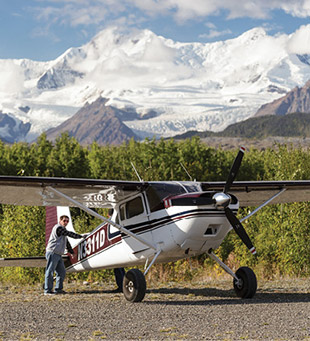
While stomping around the Alaska wilderness may not be for everyone, just about every pilot is curious about that vast state and its use of airplanes. Editor in Chief Tom Haines had the chance to do some “gentleman’s” backcountry flying in a fascinating part of Alaska (“Great Escape,” page 50.) “The Copper River Basin is off the beaten path, but still very accessible,” said Haines, who spent a few days plying the gravel and dirt strips in the region as well as creating a few ripples on Lake Louise in a seaplane. “With lakes, mountains, and glaciers, the basin is hauntingly beautiful. The pilots we ran into can’t imagine flying anyplace else. Now I understand why.”
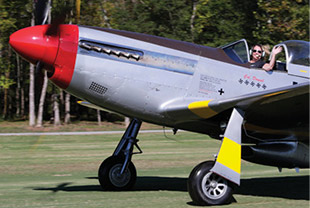
Opportunities to fly in a P–51 Mustang don’t come around often, so when Senior Features Editor Julie Summers Walker was enticed to visit Triple Tree Aerodrome in South Carolina with that as a carrot, she jumped at the chance (“Neverland,” page 60). Alas, mechanical difficulties with nearly every one of the vintage aircraft that are hangared at Triple Tree plagued them the day she visited. But for some eye-candy photographs, instructor Mark Murphy helped Walker into the iconic warbird for a taxi down Triple Tree’s 7,000-foot runway. “Toss ego and vanity out the door and maneuver yourself into that ancient cockpit and visualize yourself in this massive beast,” Walker said. “Its engine roars and it lumbers its way down the runway. The taxi was a tease and I hope one day I am in the sky with this thrilling aircraft.”
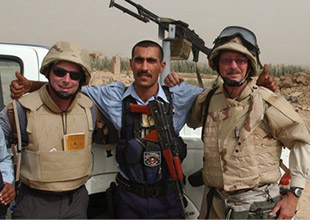
This was AOPA Editor at Large Dave Hirschman’s first trip to Burning Man (“Like a Mirage,” page 68), but not the first time he’d camped in the desert. As an embedded reporter with the U.S. Army in 2006, he spent several months covering the war in Iraq where the climate, food, and accommodations were remarkably similar. “Heat, cold, wind, dust, sleeping in a tent,and eating MREs was like being in Iraq without getting shot at,” Hirschman said. “On my first night at Burning Man, I just about jumped out of my sleeping bag when I heard a series of mortars fired in rapid succession. Happily, it turned out to be the start of a fireworks display, but that distinctive sound sure got my attention.” The airport that exists for two weeks a year draws a fascinating cross-section of pilots and aviation enthusiasts. “They’re a smart, colorful, fun-loving, and welcoming group who turn a dry lake bed into a bustling airport,” Hirschman said. “It runs incredibly smoothly, and then it’s gone.” Pilots known as “serial gifters” for providing airplane rides gained his admiration. “They go to extraordinary lengths to introduce strangers to aviation in a positive way,” he said. “They do it with flair and good cheer, and they represent the very best of our aviation community.”
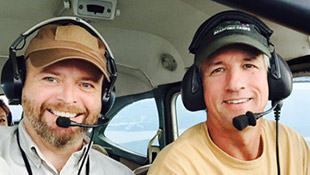
“My summers at camp unfortunately ended almost 30 years ago,” says Photographer Chris Rose. “Memories of friendships, the smell of wood smoke, and lake-water-soaked clothes left in a duffel bag still put a smile on my face.” So when the opportunity came to relive a slice of his youth in the Maine woods, he was in (“Summer Camp,” page 78). Rose and author Julie Summers Walker flew with camp owner and pilot Igor Sikorsky III. “What makes Bradford Camps so surprising is that it’s not really surprising at all,” Rose says. “It’s exactly what you want it to be, and that’s a great thing. From its quaint log cabins and stone fireplace to the smell of coffee and wet pine needles in the morning, this place is one moose shy of a Thoreau essay. After a weekend of seaplanes, laughter, stories, and great food, I departed with exactly what I come (back) for—new friends; a duffel bag full of wet, wood-smoked clothes; fun photos, and, thankfully, no poison ivy.”


